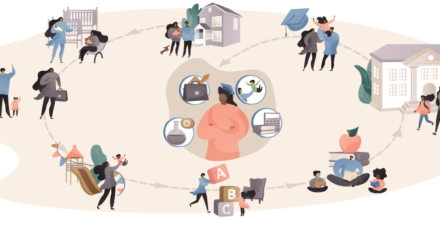Executive actions to leverage federal agencies to improve child care in the United States

Overview
The decisions families make about child care are hugely consequential for each individual child and family, as well as for the U.S. economy as a whole. Yet despite its importance, the child care system in the United States is failing to meet the needs of working families.
Fewer U.S. children live with a full-time stay-at-home caregiver yet rising demand for child care hasn’t translated into a commensurate increase in the supply of affordable, high-quality care. In many states, child care is more expensive than the cost of public college. Yet despite these high prices, child care workers are some of the lowest-paid workers in the U.S. economy.
The COVID-19 pandemic only exacerbated these problems. Emergency pandemic investments helped keep the child care industry afloat, but those investments did not address many of the underlying issues that have plagued the sector for years. As a result, the COVID-19 recession in 2020 led to a decline in child care workers, and the child care industry is still recovering more slowly than the overall U.S. economy.
But the pandemic is only a piece of this story.
Child care has been systematically disinvested in and deprioritized for decades. This remains the case today despite research showing that investing in child care would have positive reverberations throughout our economy. Such investments would allow parents to reenter the workforce, support positive development among children, and improve working conditions and pay for millions of low-income child care workers.
Below, we detail some executive actions the Biden administration can take to help facilitate the process of providing better child care and boosting the overall economy. The actions listed here aren’t exhaustive, but they would make strides toward providing better support for U.S. children, families, and caregivers, in turn boosting broad-based economic growth and well-being.
Convene state policymakers, practitioners, and experts to review outcomes from the American Rescue Plan’s child care provisions
The American Rescue Plan Act marked a historic, albeit temporary, investment in child care following the COVID-19 recession. Billions in supplemental Child Care Development Fund money and stabilization grants allowed states to develop the policies and infrastructure that could support future, more permanent public investments in child care.
Some states are experimenting with navigator pilot programs similar to Unemployment Insurance to help unlicensed child care providers become eligible for relevant government resources. Colorado and Minnesota have launched their own licensing incentives that make use of navigators providing assistance to caregivers to help them meet licensing requirements. These experimentations are a step in the right direction, but they remain an underutilized tool.
Such lessons and experiments could pave the way for federal pilot programs replicating local success on a national scale. The White House should convene state policymakers, scholars, child care providers, and other policy experts to discuss opportunities for further research and evaluation of lessons learned from this unique investment in child care. Holding such a convening would help key stakeholders learn what works, what doesn’t, and what could be replicated on a broader scale in the future.
Indeed, other policies and ideas could emerge to help improve the supply of child care in the United States. Participants could examine state-level experiments that address the nonfinancial costs of expanding supply and tailored incentives that address unique constraints faced by different providers—both of which have been examined by Gina Adams at the Urban Institute. Relevant data catalogued by Alycia Hardy at the Center for Law and Social Policy, Katherine Gallagher Robbins at the National Partnership for Women & Families, and Clare Waterman at Child Care Aware of America could also be used to help inform discussions.
Convene a summit or create a federal commission on child care deserts
The term “child care desert” has been popularized by researchers, such as Rasheed Malik at the Center for American Progress, to describe areas of the United States with so few child care providers or available slots that there isn’t enough capacity to meet demand. More specifically, this term can be defined as an area where there are more than three young children for every one licensed child care slot. Just more than half of families across the country live in child care deserts, pointing to an urgent deficiency in the supply of child care.
How child care deserts develop, and how they can be eliminated, requires further research and a multidisciplinary approach. Yet due to privacy considerations, independent researchers cannot always access accurate geographic data on home-based or unlicensed child care providers. And while high-quality data can help identify where child care deserts exist, the experiences of current providers, former providers, and families themselves can shed light on how they form in the first place.
Federal agency support can bolster research on this important topic. Through the development of a commission on child care deserts, the U.S. Department of Health and Human Services can convene advocates, researchers, child care professionals, and families to share their expertise and experiences on this topic. These key stakeholders can provide insight into how to best support researchers working with states to collect comprehensive data and recommend solutions to expand the supply of care. A commission also would formalize the concept of a child care desert and, in turn, could help policymakers better target federal resources.
Require the U.S. Census Bureau to provide descriptive child care information and ongoing updates to baseline data on families’ child care arrangements
An accurate understanding of the scope and types of child care arrangements that families use in the United States is crucial, as it allows the government to assess and identify trends among families and across time. Such descriptive data analyses, including updating prior research, can be cost- and time-intensive for independent researchers, but it is invaluable for advocates and policymakers.
The U.S. Census Bureau’s “Who is Minding the Kids?” report, for example, was a great tool for providing information on families’ child care arrangements, but the analysis was most recently conducted in 2013 and used even older data. The Census Bureau should reinvest in this type of research to help provide baseline data on the variety of U.S. child care arrangements. This would not only help stakeholders better understand the lay of the land but also help government agencies cater programs more effectively and better identify needs among families.






